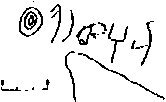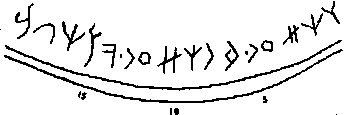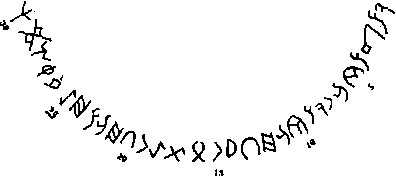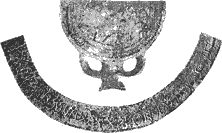Back
In Russian
Codex of Inscriptions - Index
Roots
Alphabet
Writing
Language
Religion
Geography
Archeology
Coins
Wikipedia
Turanian Writing
Paleography of 8 Türkic Alphabets
Ogur and Oguz
Avar Dateline
Besenyo Dateline
Bulgar Dateline
Huns Dateline
Karluk Dateline
Kimak Dateline
Kipchak Dateline
Kyrgyz Dateline
Sabir Dateline
Seyanto Dateline
Türkic Scripts - Codex of Inscriptions
Euro Asiatic Subgroup
Don Script
Introduction
I.L Kyzlasov in his book Writings Of Eurasian Steppes assembled
a Codex of Inscriptions. The Euro Asiatic group, per I.L Kyzlasov, includes
Don, Kuban, S. Enisei, Achiktash, and Isfar scripts.
I.L Kyzlasov attributs the Don script to both Bulgar and Alan populations of
the Khazaria,
noting that the Don script is not associated with the monuments of the
distinct burial rites, but connected with the kurgan burials, and also with
the rock and catacomb burials of the Saltovo-Mayak culture in the period of
the 8-th - 10-th centuries.
Codex of Inscriptions- Don
Graffiti on a fragment of the chalk block of the fortification. A horizontal line of seven characters.
The exact dimensions of the characters are unknown.
Date - 9 c.
Found in 1899 by D.M.Strukov at excavation of the wall of the Mayak citadel,
on the river Don near the confluence with river Quiet Fur (in Russian-Tikhaya Sosna) (Fig. 1,7).
The monument is known from a photo. It was stored in the engraving room of the
Rumyantsev museum in Moscow. By 1902 it could not be found. D.M.Strukov
archives are located in GIM (Russian State Historical Museum in Moscow Red Square- Translator's Note).
D 1. Drawing by author from photo of N.E. Makarenko
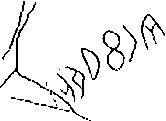
Publications:
Makarenko N.E. Archeological researches of 1907-1909. - ILK. 1911, issue. 43, Fig. 23, pp. 1, 23.
Attempts to read:
Shcherbak A.M. About methods of reading the Don runic inscriptions. -
SA. 1954, 19, pp. 274, 275;
Shcherbak A.M.Characters on ceramics and bricks from Sarkel-Belaya Veja.
- MIL. 75, 1959, p. 386
Transliteration
Uma (or Ama) EngÜsh
(or EngEsh)
AtYbY...
Translation
Uma and Angush - our names
Turchaninov G.F. Language of inscriptions on Mayak citadel stones and flasks in the Novocherkassk museum. - SA. 1964, No 1, pp. 77, 78; Turchaninov G.F. Monuments of the script and language of peoples of Caucasus and the East Europe. L., 1971, pp. 66-74;
Transliteration
in Alanian (Ossetian)
...Alanuy Kan
Translation
Kan of Alans
Baichorov S.Ya. Old Türkic runic monuments of the Europe. Stavropol, 1989, pp. 59-62, 160.
Transcription
Not available
Transliteration
Shug(a)ymek
Translation
Shugaymek (proper name)
D 2. Mayak -2
Graffiti on a
fragment of the chalk block of the fortification. A horizontal line of six characters.
Length 8 sm. Letter height 2-3.2 sm.
Date - 9 c.
Found in 1909 by N.E. Makarenko at excavation of the wall of the Mayak
citadel.
In custody of SH (Russian State Hermitage in present St. Petersburg - Translator's Note)
custodian No 1929/3.
|
D 2. Drawing by author |
D 3 and D 4. Relative position. Drawing by author |
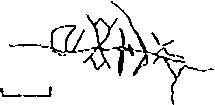
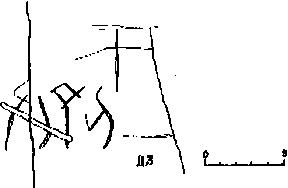
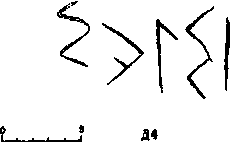
Publications:
Makarenko N.E. Archeological researches of 1907-1909. - ILK. 1911, issue.
43, Fig. 19, 20, p. 22.
Baichorov S.Ya. Old Türkic runic monuments, Table 118, 118a
Kyzlasov I.L. Runic inscriptions in the Mayak citadel. - Mayak archeological compound. M., 1990,
Fig. 2, p. 10, 12;
Kyzlasov I.L.Euroasian Old Türkic runic script. M., 1990,
Fig. 3, 7, p. 6, 9, 11.
Attempts to read:
Shcherbak A.M. About methods of reading the Don runic inscriptions. -
SA. 1954, 19, p. 275
Shcherbak A.M.Characters on
ceramics and bricks from Sarkel-Belaya Veja. - MIL. 75, 1959, p. 386
Turchaninov G.F. Language of inscriptions on Mayak citadel stones and flasks
in the Novocherkassk museum. - SA. 1964, No 1, pp. 77, 78;
Turchaninov G.F. Monuments of the script and language of peoples of Caucasus
and the East Europe. L., 1971, pp. 67-72;
- S.Ya.
Baichorov explains that "the photos were made with the slab upside down. G.F. Turchaninov
read this upside down image."
Baichorov S.Ya. Old Türkic runic monuments of the Europe. Stavropol, 1989, pp. 154-158.
Transcription
(S.Ya.
Baichorov reads a single inscription below on fragments D2, D3, and D4)

Transliteration
1) (E)s(i)nch d(o)g(y)nch.....kh.....
2) ......Elmekh.....dj.....oydu...
Translation
1) Remembrance - memorial
2) .....Elmekh.....chiseled....
D 3. Mayak -3
Graffiti on two adjacent fragments of the chalk block of the fortification wall. A horizontal line of
three or four characters. Length 6.5 sm. Letter height 3.5 sm, first character on the right - 4 sm.
Date - 9 c.
Found in 1909 by N.E. Makarenko at excavation of the wall of the Mayak
citadel.
In custody of SH custodian No 1929/4,5.
Publications:
Makarenko N.E. Archeological researches of 1907-1909. - ILK. 1911, issue.
43, Fig. 19, 21.
Baichorov S.Ya. Old Türkic runic monuments, Table 118, 118a
Kyzlasov I.L. Runic inscriptions in the Mayak citadel. - Mayak archeological compound. M., 1990,
Fig. 2, p. 10, 12;
Kyzlasov I.L.Euroasian Old Türkic runic script. M., 1990,
Fig. 3, 2, p. 6, 11.
Attempts to read:
Shcherbak A.M. About methods of reading the Don runic inscriptions. -
SA. 1954, 19, p. 275
Shcherbak A.M. Characters on
ceramics and bricks from Sarkel-Belaya Veja. - MIL. 75, 1959, p. 386
Turchaninov G.F. Language of inscriptions on Mayak citadel stones and flasks
in the Novocherkassk museum. - SA. 1964, No 1, pp. 79;
Turchaninov G.F. Monuments of the script and language of peoples of Caucasus
and the East Europe. L., 1971, pp. 67-72;
Baichorov S.Ya. Old Türkic runic monuments of the Europe. Stavropol, 1989,
pp. 154-158. (See D2 above)
D 4. Mayak -4
Graffiti on the
same chalk block as D3. A horizontal line of five characters.
Length 10.7 sm. Letter height 4 to 5.7 sm.
Date - 9 c.
Found in 1909 by N.E. Makarenko at excavation of the wall of the Mayak citadel.
In custody of SH custodian No 1929/4.
Publications:
Makarenko N.E. Archeological researches of 1907-1909. - ILK. 1911, issue.
43, Fig. 19, 22.
Baichorov S.Ya. Old Türkic runic monuments, Table 118, 118a
Kyzlasov I.L. Runic inscriptions in the Mayak citadel. - Mayak archeological compound. M., 1990,
Fig. 2, p. 10, 12;
Kyzlasov I.L.Euroasian Old Türkic runic script. M., 1990,
Fig. 3, 3, p. 6, 11.
Attempts to read:
Shcherbak A.M. About methods of reading the Don runic inscriptions. -
SA. 1954, 19, p. 275
Shcherbak A.M.Characters on
ceramics and bricks from Sarkel-Belaya Veja. - MIL. 75, 1959, p. 386
Turchaninov G.F. Language of inscriptions on Mayak citadel stones and flasks
in the Novocherkassk museum. - SA. 1964, No 1, pp. 79;
Turchaninov G.F. Monuments of the script and language of peoples of Caucasus
and the East Europe. L., 1971, pp. 67-72;
Baichorov S.Ya. Old Türkic runic monuments of the Europe. Stavropol, 1989,
pp. 154-158. (See D2 above)
D 5. Mayak -5
Graffiti on a
fragment of the chalk block of the fortification wall. A horizontal line of six characters.
One of the letters is damaged, left character looks like a
tamga. Length 8.7 sm. Letter height
1.9 - 3.2 sm (mostly 2.5 sm).
Date - 9 c.
Found in 1909 by N.E. Makarenko at excavation of the wall of the Mayak citadel.
In custody of SH custodian No 1929/1.
|
D 5. Drawing by author
|
D 5. Baichorov S.Ya. Ancient Turkic runic monuments, table 120
|
Publications:
Makarenko N.E. Archeological researches of 1907-1909. - ILK. 1911, issue.
43, Fig. 27 p.27.
Baichorov S.Ya. Old Türkic runic monuments, Table 120
Kyzlasov I.L. Runic inscriptions in the Mayak citadel. - Mayak archeological compound. M., 1990,
Fig. 2, p. 10, 13;
Kyzlasov I.L.Euroasian Old Türkic runic script. M., 1990,
Fig. 3, 4, p. 6, 11.
Attempts to read:
Shcherbak A.M. About methods of reading the Don runic inscriptions. -
SA. 1954, 19, p. 276
Shcherbak A.M.Characters on
ceramics and bricks from Sarkel-Belaya Veja. - MIL. 75, 1959, p. 386
Turchaninov G.F. Language of inscriptions on Mayak citadel stones and flasks
in the Novocherkassk museum. - SA. 1964, No 1, pp. 79;
Turchaninov G.F. Monuments of the script and language of peoples of Caucasus
and the East Europe. L., 1971, pp. 67-72;
Baichorov S.Ya. Old Türkic runic monuments of the Europe. Stavropol, 1989,
pp. 61, 62, 158, 159.
Transcription

Transliteration
Elbeg
Translation
Elbeg (proper name)
D 6. Mayak -6
Graffiti on the chalk block of the
fortification wall. Remains of the two (?) inscriptions of three vertical
lines, top to bottom and located between drawings of horces. Length line 1 -
6.3 sm, line 2 - 8 sm, line 3 - 8.5 sm. In line 1 two groups of three and two
characters separated by 2.6sm space. In line 2 five characters separated by a
cleave, in line 3 three characters in the same position.
Date - 9 c.
Found in 1909 by N.E. Makarenko at excavation of the wall of the Mayak citadel.
In custody of SH custodian No 1929/10.
Publications:
Makarenko N.E. Archeological
research of 1907-1909. - ILK. 1911, issue.
43, Fig. 28.
Kyzlasov I.L. Runic inscriptions in the Mayak citadel. - Mayak archeological compound. M., 1990,
Fig. 3p. 10, 13, 14;
Kyzlasov I.L. Euroasian Old Türkic runic script. M., 1990,
Fig. 4, p. 6, 8, 11-13.
Pletneva S.A. Drawings on the walls of the Mayak citadel - Mayak citadel. M., 1984, Fig. 3;
Pletnjowa S.A. Die Chasaren. Lpz., 1978, Abb. 70.
Attempts to read:
Never published
D 5. Drawing by author Drawing by author
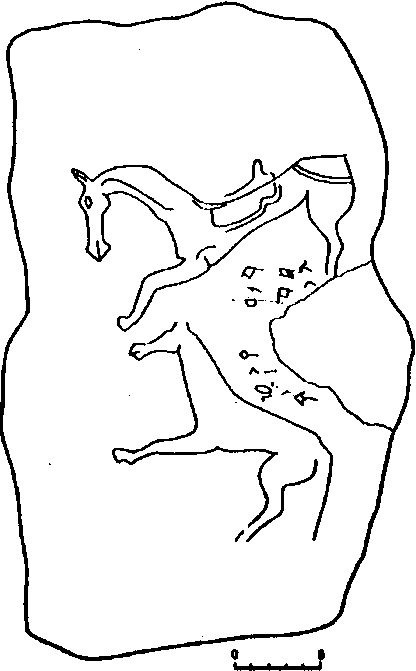
The first stone with the Türkic inscription D 1 in the Mayak citadel was found by amateur digger D.M.Strukov in 1899 in the top part of the collapced internal veneer of the southwest wall approximately at equal distance from the gate and the southern corner of the fortress. The picture of the inscription was kept in the D.M. Strukov archive (the stone, probably, iwas lost after the death of the researcher) and was published by N.B.Makarenko in 1911. Nowadays it is an only known source for study of the inscription. In a photo are distinctly six thinly cut characters, and only the shape of the seventh (at the extreme left) is doubtful. Probably, it is vertical line. S.Ya.Bajchorov re-published the photo of the inscription in 1989,the author of these lines published in 1990 the drawing from the picture. In the same year were published the archive records about the circumstances of the find of this inscription.
The first large archeological excavations in the Mayak citadel, classified as the "Saltovo-Mayak " culture and dated by the 9 c., was performed by N.E.Makarenko in the 1908-1909. In 1909 he found three brief texts D 2 - D 4, cut on the adjacent stones in the masonry of the internal part of the fortification near the gate. At the same time N.E.Makarenko found two separate blocks with inscriptions D 5 and D 6. Probably, they came from the break in the wall,the available data in the report does not allow to establish precise location. Realizing the scientific importance of the finds, N.E.Makarenko transported parts of the blocks with inscriptions, D 2 - D 6 to the Hermitage, and in 1911 in the full account of the excavation published the pictures.
The study of the D 2 original in comparison with the issued reproduction does not help. The text is strongly damaged. Confidently can be discerned only one character, and with the larger or smaller hesitation the other five. The length of a line did not exceed 8 sm, the height of letters did not exceed 2-3,2 sm. Probably, the text "is placed" on the block upside down. Written quite clearly on the same block as the D 3, the inscription D 4 nevertheless is difficult to perceive. It is difficult to tell if the five characters making it in relation to the two other lines are placed: mirror-wise or "upside down" (if the printer did not make mistake, the inscription was perceived so by N.E.Makarenko). Proceeding from the placement of similar characters in the other Mayak inscriptions (tab. I, _ 5, 11, 19), comes the conclusion that inscription D 4 is "upside down" on the block in relation to the line D 3, and the second character in it has a mirror turn. Consideration of the arrangement of the inscriptions D 2 - D 4 in the masonry of the wall of the two adjacent chalk blocks does not contradict this. The poor condition of the D 2 does not allow to tell confidently how its characters were located, they also might have been rotated in relation to the D 3. Strictly speaking, only the inscription D 3 was, undoubtedly, made on the blocks after their installation in the wall masonry, its characters are traced on both the two adjacent blocks. It is left to presume that lines D 2 and D 4 were made before their use by the builders. A significant cleave in the middle of the line prevents a clear understanding of the third character from the right of the inscription D 5. The five others are clear. The last character at the left, same size as the others, probably, is not a character, and it is possible to perceive as the complicated variation of a circle rune, even though it was incised by if not the same, then with a similar tool.
Inscription Ä 6 consists of very fine characters and contains not less than three lines of the text with the middle at first sight completely destroyed by a large cleave. The text is located between the figures of horses and, by its appearance, was made after the pictures. The differing opinion of N.E.Makarenko was based, probably, on the study of the deeper and, hence, earlier lines. In relation to the horses the text is located in vertical lines. By the inclination of letters, the inscription also was made not horizontally, but vertically, i.e. both for the painter, and for the inscriber the position of the stone was the same. The first line consists, probably, of two groups of the characters containing accordingly three and two characters and divided by a 2,6 sm space without letters. The shape of the third character, probably, is not complete, as its left part is covered by a later scratch. Five characters of the second line are divided by a major cleave, but none of the adjacent letters are damaged. Looking at the third character separated from cleave by a small gleam, and above the top of the cleave there are no characters which would be expected here, it is possible to assume that the inscription bypassed the damage on the surface. The third line preserved only three characters (one to the left of the cleave and two on the right). The second character may be interpreted differently. More to the right of the third character is light cuts, which could be taken for traces of the letters for the following line, but they look differently and, hence, most likely are not connected with the text. The arrangement of characters Ä 6 in relation to the horse figures does not leave doubt, that the lines were written from right to left and, probably, from the top down, and, consequently, should be read in the same direction. As we see, the space between the characters divided by the cleave lines may testify against the unity of this small written monument. Most likely, here are closely placed two brief texts. If it is so then each of them pertains to one of the images of the horses: D 6/1 to the top, and D 6/2 to the bottom figure. This assumption explains also the composition of the inscriptions, they both were hidnered by the already present surface cleave between the horses . The question of the treatment of the texts D 6 will be solved only after a reliable reading of the characters. Probably, as a key to this puzzle may serve a guess that the stone shows the names of the horses . Per N.E.Makarenko, on the adjacent surface of the block, next to the inscription, was a tamga-looking sign.
Inscriptions D 1 - D 5 were originally studied by the archeologists. Their sketches and prints are in the archives of V.A. Gorodtsov and A.A.Miller. M.I.Artamonov first addressed the questions of dating, ethnic affiliation and the comparative-typological analysis of these inscriptions, in connection with thr study of larger epigraphical materials of the Eastern Europe. Due to this the Mayak inscriptions drew the attention of the domestic (Russian - Translator's Note) linguists. In 1954 A.M.Shcherbak attempted to read the Mayak inscriptions as Türkic texts. In the work were reproduced schematically the drawing images of the inscriptions D1 - D 5 made by M.I.Artamonov . In 1971. they were re-published by J.Nemeth. In 1964 G.F.Turchaninov read the Mayak texts as Iranian, and D 5 - as Semitic. The researcher published the drawings of the inscriptions made, apparently, from the photos of N.E.Makarenko.
In 1989 S.J.Bajchorov's re-published D 1 - D 5 with the N.E.Makarenko's pictures, published his drawings of the inscriptions, and the evaluation of the predecessors' publications. The researcher, offering new readings of the stone-cut lines in Türkic, sees in D 2 - D 4 three parts of the previously uniform two-line text. However his arguments, apparently, are based on the study of the photos, instead of the original monuments. Because of the bad preservation of the text, linguists did not study and did not publish the inscription D 6. A good photo of this stone was repeatedly published by S.A Pletneva, who investigated the images of horses next to the runic characters. In 1990 new sketches of the originals D 2 - D 6 were published by the author, who offered the description of the inscriptions and their paleographic analysis.
D 7. Salsk - Tsaritsyn
Graffiti on the
baked side surface of a clay vessel. An arch-like line of 18 characters,
dimensions are not given in publications.
Date - 8-10c.
Accidental find during construction of Salsk-Tsaritsyn railroad in 1909. Exact
location is not known (Fig. 1,3).
Located in Novocherkassk museum.
|
D
7.
Drawing by author from photos of . M.I.Artamonov and A.A.Miller |
D 7. Baichorov S.Ya. Ancient Turkic runic monuments, table 113
|
Publications:
Artamonov M.I.
Inscriptions on flasks from Novocherkassk museum and stones from Mayak citadel. - SA. 1954, 19,
p. 263-268;
Baichorov S.Ya. Old Türkic runic monuments, Table 113
Attempts to read:
Bernshtam A.L. Old Türkic
script from River Lena. - EV, 1951, 4
Shcherbak A.M. About methods of reading the Don runic inscriptions. -
SA. 1954, 19, p. 274
Shcherbak A.M. Characters on
ceramics and bricks from Sarkel-Belaya Veja. - MIL. 75, 1959, p. 386, 387
Shcherbak A.M. About runic script in South-Eastern Europe. - ST 1971, No 4, p.
77
Turchaninov G.F. Language of inscriptions on Mayak citadel stones and flasks
in the Novocherkassk museum. - SA. 1964, No 1, pp. 84, 85;
Turchaninov G.F. Monuments of the script and language of peoples of Caucasus
and the East Europe. L., 1971, pp. 77, 78;
Transliteration
lukxa • Kaisykh • kan • Kaisykhi
Translation (Kasogian, equated by G.F.
Turchaninov with Cherkessian [Adygian group] languge)
Brave was • Kaisykh-kan (pupil of) Kaisykh
Baichorov S.Ya. Old Türkic runic monuments of the Europe. Stavropol, 1989, pp. 146-151.
. Transcription

Transliteration
B(i)ch bit(i)k umuch bit(i)k u (e)n echeshe
Translation
Engraved inscription - inscription of hope. This (belongs to) home (=lodge)
D 8. Krivyanskoe
Graffiti on the
baked side surface of a clay vessel. An arch-like line of 30
characters, dimensions are not given in publications.
Date - 8-10c.
Accidental find during construction of the defence fortifications in 1942 near
stanitsa Krivyanskoe near Don (Fig. 1,4).
Located in Novocherkassk museum.
|
D 8. Drawing by author from photos of M.I.Artamonov and A.A.Miller
|
D 8. Baichorov S.Ya. Ancient Turkic runic monuments, table 116
|
Publications:
Artamonov M.I.
Inscriptions on flasks from Novocherkassk museum and stones from Mayak citadel. - SA. 1954, 19,
p. 263-268;
Baichorov S.Ya. Old Türkic runic monuments, Table 116
Attempts to read:
Shcherbak A.M. About methods of reading the Don runic inscriptions. -
SA. 1954, 19, p. 272-274
Shcherbak A.M. Characters on
ceramics and bricks from Sarkel-Belaya Veja. - MIL. 75, 1959, p. 386, 387
Turchaninov G.F. Language of inscriptions on Mayak citadel stones and flasks
in the Novocherkassk museum. - SA. 1964, No 1, pp. 83-84;
Turchaninov G.F. Monuments of the script and language of peoples of Caucasus
and the East Europe. L., 1971, pp. 75-77;
Baichorov S.Ya. Old Türkic runic monuments of the Europe. Stavropol, 1989,
pp. 62-68, 151-154.
Transcription
![]()
Transliteration
En echeshe u en eshe dj(a)shay o (e)bde ush djeedjag(y)ng (a)rakd [(a)rakdy]
ich
Translation
Vessel of the house (lodge), this is sanctuary-home (lodge). Living in this
house, the last you will taste is araka. Drink!
Both ceramic
flasks, apparently, also belong to the Saltovo-Mayak culture. Comparative -
typological determination of the vessel dating is 8-10 c. Vessels and their runic texts were
published in 1954 by M.I.Artamonovwith good photos. Inscription D 7 in
M.I.Artamonov materials was published by A.N.Bernshtam, who in 1951
transcribed its characters by the academic runic font and offered a reading of
the monument. A.M.Shcherbak and G.F.Turchaninov also attempted to read both inscriptions
(in 1971 J.Nemeth re-published M.I.Artamonov's photos and A.M.Shcherbak's
drawings). Both researchers compared characters on vessels with the inscriptions
of the Mayak citadel (D 1 - D 5), published by N.E.Makarenko, and A.M.Shcherbak
- also compared characters with Orkhon-Yenisei and Nady
St Miclosh letters. A.N.Bernshtam denied the similarity of these monuments to
the Mayak inscriptions and the Hungarian treasure characters. In 1989
S.Ya.Bajchorov recounted in detail the history of the study of both written monuments,
re-published the M.I.Artamonov's pictures, drawings of the of predecessors, and,
complementing with his own drawings of the originals, suggested new readings and translations, based on
his decoding of the generalized European runic inscriptions.
The History of the Salsk inscription D 7 study should include the materials from
the A.A.Miller archive, who believed that "this inscription is in close link with
the inscriptions from the Mayak citadel" and the
tamgas of the south of Europe, and correlated
the characters with the Orkhon alphabet. He asked S.E.Malov to study the inscription,
and he made the cautious conclusion dated January, 12, 1927, where in the opinion
of the Türcologist, the letters are similar to the runic alphabet known at that time only
at the first sight. It is essential, that S.E.Malov later also did not publish
his results about the Salsk inscription.
Inscriptions on vessels were studied by us from the published and archival photos that resulted in the publication
of the drawings made from them. The drawings and a picture in the fund of
A.A.Miller allow clearly portray the Salsk inscription. The shape of some characters
in the Krivyansk flask remained not quite clear (No 8, 16, 17, 27). In both inscriptions the size of characters
increased from right to left.
D 9. Kermen-Tolga
Graffiti on the
cranial of a bull in damaged condition. The frontal part bone has three horizontal lines one
of which is placed upside down in relation to others. Parttially or completely
were preserved 57 characters. On the smaller fragments "a" - "d" are from three to seven characters. On four fragments, designated by the letter "e",
are only separate parts of the characters. Eight characters of a fragment
"j", apparently, are not alphabetical, but counting. The size of the characters
are from 0.9-1.4 to 2.4 sm.
Date - 8-10 c.
Found in 1970 in the plundered burial of a kurgan Kermen-Tolga 12 km east of Elista
town during I.V.Sinitsyna's and U.E.Erdnisva excavations (Fig. 1,5).
In custody of SH custodian No None.
D 9 Main part. Drawings by author
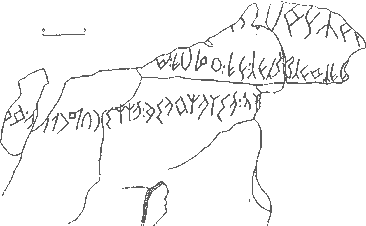
D 9 Per U.E Erdniev, D 9/a-D 9/j - Drawings by author
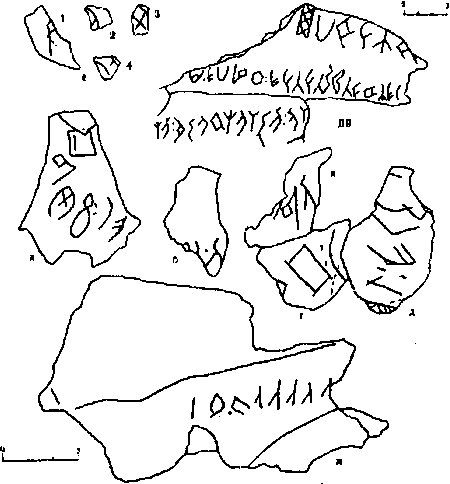
Publications:
Klyashtornyi S.G., Vasari I. A Runic Inscription on a Bull-Scull from the Volga Region. - Between the Danube and the Caucasus. Kyzlasov I.L Old Türkic runic script of Eurasia, Fig.13, 14, p. 42-47.
Attempts to read:
Never published
Transcription
Not available
Transliteration
Not available
Translation
Not available
In 1971, on the 5th Türcologist conference in Leningrad, Klyashtornyi told about the find, dating it 8-10 c. putting it put in the same type with Novocherkassk, Mayak and Khumarian inscriptions, and has defined the letters as Khazarian. In 1982. U.E Erdniev published the description of the excavation and photos of the inscription. However the illustrations were weak technically . While preparing the new publication of the materials in the next collection of Kalmyk Scientific Research Institute, U.E.Erdniev acquainted the author with the originals of the photos. Expressing a profound gratitude to the researcher, we shall note, that without these documents it would be impossible to determine the initial interposition of the separate parts of the text, as the skul bones undergone additional destruction after their initial restoration. In 1987 S.G.Kljashtornyi and I.Vashari published good photos and drawings of the skull. with an inscription. They documented one more match of the two small fragments with characters (fragment 3), gave the descriptions of the find (conflicting in details with U.E.Erdniev story), and showed the parts of a skull with the text. Our work with the original resulted in diferent from the named authors understanding of some characters, and the brevity of the published description has induced to document the observations essential to the understanding of this written monument. The new drawings were published in 1990.
The main part of the skull above the eye-socket and the ancient break of the bone has the remains of three lines, the beginnings and the ends of which are broken off. Probably, from them come the four fine fragments with the traces of incomplete runic characters, and five larger pieces, three of which (by comparing data from U.E.Erdniev, S.G.Klyashtornyi and I.Vashari) originally were a single bone. This situation contradicts the designations of fragments offered by researchers in the past. We marked the fragments with letters from "a" up to "d", "e" (four fine slices) and "j". As the character bottoms in the lines of text, separated by the bone crest, are in the opposite directions, conditionally we designate the first the one which base is directed to the eye-sockets of a skull, and two others accordingly as the second and third. Joining the fragments "b" and "g" separated by the bone crest, the lines here face each other with their bottoms. Accepting the connection of three fragments "b" - "d", we receive a convergence of three lines, one of which is perpendicular to the rest. Apparently, originally on the cranial bone was more than three written lines. This assumption is not contradicted also by the fragment "j", which has eight carved characters (the first on the right survived only partially) which, probably, are not alphabetical, but counting signs. Uniqueness of the monument is not only in the change of a direction of some lines, but also in their orientation to each other from 90° to 180°.
Now in the first line of the text are 26 characters, of which twenty four were recognized, in the second line accordingly 22 and 21, in the third, considering the published materials, 9 and 6, on the fragments "a" - "d" are 6 and 6, 3 and 1, 3 and 2, 4 and 3, 7 and 5. The abovestated reasons do not allow to involve in the paleographic analysis the fragments "å" and "j". Thus, we have 68 characters. All of them are deeply and clearly cut with a sharp cutter. The right to left direction of the letters is definitely evident from the order of characters on the fragment "a".
S.G.Kljashtornyi and I.Vashari identify the Kermen-Tolga inscriptions as the so-called Khazarian Script (its carriers, however, were determined to be Bulgars) described in the comparative table of characters on the skull, Novocherkassk flasks, .Mayak stones, and Khumar citadel. However such linkage of the monuments is not completely justified paleographically. The inscriptions of the Khumar citadel belong to the Kuban alphabet.
D 10. Mayak -7
Graffiti on a
fragment of the chalk block of the fortification wall. A horizontal line of
seven characters. The size of the inscription is unknown.
Date - 9 c.
Found in the Mayak citadel at the mouth of Quiet Pine River under unknown circumstances,
probably in 1910-1920es. Brought to the museum by a certain Turbina. It is known
from sketches of S.N.Zamjatnin without scale.
Was located in the pre-war collection of the Voronezh museum, destroyed in 1942.
D 10 Per S.N. Zamyatin

Publications:
Kyzlasov I.L. Runic inscriptions in the
Mayak citadel. - Mayak archeological compound. M., 1990,
Fig. 4, p. 14, 15;
Kyzlasov I.L. Euroasian Old Türkic runic script. M., 1990,
Fig. 2,2, p. 13, 17.
Attempts to read:
Never published
Transcription
Not available
Transliteration
Not available
Translation
Not available
D 11. Mayak -8
Graffiti on a
fragment of the chalk block of the fortification wall. A horizontal line of
five characters. The size of the inscription is unknown.
Date - 9 c.
Found in the Mayak citadel under unknown circumstances, probably in
1910-1920es. Brought to the museum by a certain Turbina. It is known from
sketches of S.N.Zamjatnin without scale.
Was located in the pre-war collection of the Voronezh museum, destroyed in 1942.
D 11 Per S.N. Zamyatin

Publications:
Kyzlasov I.L. Runic inscriptions in the Mayak citadel. - Mayak archeological compound. M., 1990,
Fig. 4, p. 14, 15;
Kyzlasov I.L. Euroasian Old Türkic runic script. M., 1990,
Fig. 2,3, p. 13, 17.
Attempts to read:
Never published
Transcription
Not available
Transliteration
Not available
Translation
Not available
Attempts to read:
Never published
In the A.A.Miller archive are three sheets with seven sketches of Mayak inscriptions and graffiti . On the back of the sheet 2 is a hand-written explanatory note signed by S.N.Zamjatnin on April, 20 1954: "All three leaf are by my hand, for A.A.Miller, at the end of 20th - 6 and 7 - from sketches I had. From the same two stones in the Voronezh museum I made for A.A.Miller also two prints". Since the prints of the inscriptions in the cllection of A.A.Miller are absent, these two dimensionless sketches 6 and 7, probably, are the only survived records of the two more stones with the runic inscriptions kept in the Voronezh museum. Because there are no records in the literature, it is possible to believe that these finds were made after the excavations of N.E.Makarenko and before the end of 20es, when they were copied by S.N.Zamjatnin, i.e. in the 1910-1920es, and that stones disappeared from the collection of the Voronezh museum by the time of the start of the interest to the Mayak inscriptions between the linguists (the beginning of the 50es), and probably, in 1942. during the destruction of all the pre-war collection of the museum. According to S.N.Zamjatnin notes (sheets 1, 3), both stones come from the Mayak citadel and brought by Turbina. It should be noted that inscriptions are rendered schematically, "upside down" and reproduced on the sheets twice (sheets 1 and 3). The sketch of the inscription D 10 gives one line of the text consisting of seven characters and ended by the fracture. Above the text at the left, probably, was cut a non-letter sign. The shape of five signs is transferred clearly, separate features of the second and the third characters, probably, are exaggerated, but they also may be determined with a certain share of doubt. The inscription D 11 may be incomplete. Five characters, first of which it is damaged, also are in one line. Both inscriptions were published only in 1990, and became a subject of the paleographic analysis.
D 12. Mayak -9
Graffiti on a side of the chalk block of the fortification wall. A horizontal line of
eight characters. Lenghth 26 sm, letter height 6-8 sm.
Date - 9 c.
Found in the Mayak citadel during excavations by S.A Pletneva è G.E.Afanayev.
In custody of SH custodian No 2710/1.
D 12. Drawing by author
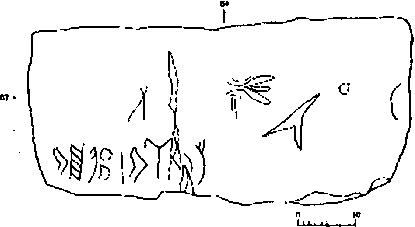
Publications:
Kyzlasov I.L. Runic inscriptions in the Mayak citadel. - Mayak archeological compound. M., 1990,
Fig. 6, p. 15, 16;
Kyzlasov I.L. Euroasian Old Türkic runic script. M., 1990,
Fig. 5, p. 18.
Attempts to read:
Never published
Transcription
Not available
Transliteration
Not available
Translation
Not available
Attempts to read:
Never published
D 13. Mayak -10
Graffiti on another
side of the same chalk block of the fortification wall. Two horizontal lines
with visible 55 characters. Length 49 and 55 sm, letter height respectively 3-4
sm and from 2.5 sm to 6 sm, mosly 3 sm.
Date - 9 c.
Found in the Mayak citadel in 1978 during excavations by
S.A Pletneva è G.E.Afanayev.
In custody of SH custodian No 2710/1.
D 13. Drawing by author
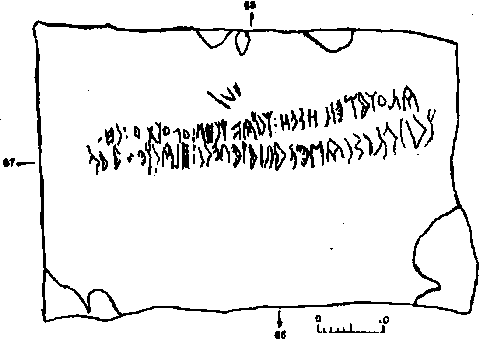
Publications:
Kyzlasov I.L. Runic inscriptions in the Mayak citadel. - Mayak archeological compound. M., 1990,
Fig. 7, p. 16;
Kyzlasov I.L. Euroasian Old Türkic runic script. M., 1990,
Fig. 6, p. 18, 22.
Attempts to read:
Never published
Transcription
Not available
Transliteration
Not available
Translation
Not available
Attempts to read:
Never published
D 14. Mayak -11
Graffiti on the
third side of the same chalk block of the fortification wall. Two horizontal lines
with visible 25 characters. Length 42.5 sm, letter height 2.5-4 sm, mostly
2.5-3 sm.
Date - 9 c.
Found in the Mayak citadel in 1978 during excavations by
S.A Pletneva è G.E.Afanayev.
In custody of SH custodian No 2710/1.
D 14. Drawing by author
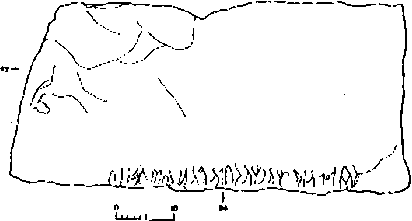
Publications:
Kyzlasov I.L. Runic inscriptions in the Mayak citadel. - Mayak archeological compound. M., 1990,
Fig. 8, p. 16, 17;
Kyzlasov I.L. Euroasian Old Türkic runic script. M., 1990,
Fig. 7, p. 22.
Attempts to read:
Never published
Transcription
Not available
Transliteration
Not available
Translation
Not available
Attempts to read:
Never published
D 15. Mayak -12
Graffiti on the
fragment of the chalk block of the fortification wall. One character height 3.4
sm.
Date - 9 c.
Found in the Mayak citadel in 1979 during excavations by
S.A Pletneva è G.E.Afanayev.
Left at the citadel. Is known from the field records of the expedition.
D 15. Drawing by S.A Pletneva
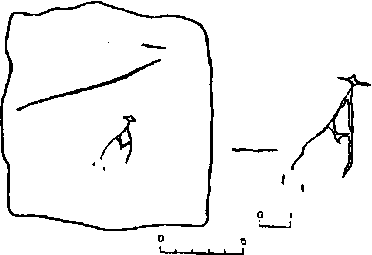
Publications:
Kyzlasov I.L. Runic inscriptions in the Mayak citadel. - Mayak archeological compound. M., 1990,
Fig. 4, p. 17;
Kyzlasov I.L. Euroasian Old Türkic runic script. M., 1990,
Fig. 8.7, p. 22.
Attempts to read:
Never published
Transcription
Not available
Transliteration
Not available
Translation
Not available
Attempts to read:
Never published
D 16. Mayak -13
Graffiti on the
butt end of the chalk block of the fortification wall. One character height 2.5
sm.
Date - 9 c.
Found in the Mayak citadel in 1981 during excavations by
S.A Pletneva è G.E.Afanayev.
Left at the citadel. Is known from the field records of the expedition.
D 16. Drawing by S.A Pletneva
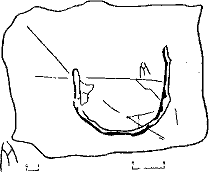
Publications:
Kyzlasov I.L. Runic inscriptions in the Mayak citadel. - Mayak archeological compound. M., 1990,
Fig. 9, p. 17, 18;
Kyzlasov I.L. Euroasian Old Türkic runic script. M., 1990,
Fig. 9.1, p. 22.
Attempts to read:
Never published
Transcription
Not available
Transliteration
Not available
Translation
Not available
Attempts to read:
Never published
D 17. Mayak -14
Graffiti on the
fragment of the chalk block of the fortification wall. A horizontal line of
five characters. Length 12.5 sm, letter height 2 to 4 sm.
Date - 9 c.
Found in the Mayak citadel in 1981 during excavations by
S.A Pletneva è G.E.Afanayev.
In custody of IA RAN (Archeological Institute of Russian Academy of Sciences - Translator's
Note).
D 17. Drawing by author
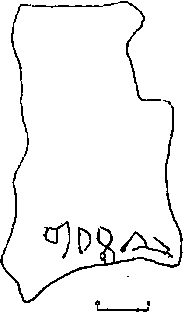
Publications:
Kyzlasov I.L. Runic inscriptions in the Mayak citadel. - Mayak archeological compound. M., 1990,
Fig. 9, p. 18;
Kyzlasov I.L. Euroasian Old Türkic runic script. M., 1990,
Fig. 8.2, p. 25.
Attempts to read:
Never published
Transcription
Not available
Transliteration
Not available
Translation
Not available
Attempts to read:
Never published
D 18. Mayak -15
Graffiti on the chalk block of the fortification wall. A horizontal line
with surviving five characters. Letter height 5.4 to 7.4 sm.
Date - 9 c.
Found in the Mayak citadel in 1981 during excavations by
S.A Pletneva è G.E.Afanayev.
In custody of the Voronezh University museum.
D 18. Drawing by S.A Pletneva

Publications:
Kyzlasov I.L. Runic inscriptions in the Mayak citadel. - Mayak archeological compound. M., 1990,
Fig. 11, p. 18;
Kyzlasov I.L. Euroasian Old Türkic runic script. M., 1990,
Fig. 8.3, p. 25.
Attempts to read:
Never published
Transcription
Not available
Transliteration
Not available
Translation
Not available
Attempts to read:
Never published
D 19. Mayak -16
Graffiti on the
fragment of the chalk block of the fortification wall. A horizontal line with
seven characters. Length 19.5 sm, letter height mostly 4.5 sm.
Date - 9 c.
Found in the Mayak citadel in 1982 during excavations by
S.A Pletneva è G.E.Afanayev.
In custody of the Museum of Book History of the Russian State Library.
D 19. Drawing by author
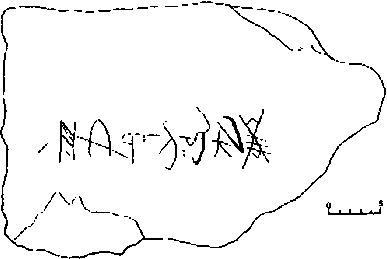
Publications:
Kyzlasov I.L. Runic inscriptions in the Mayak citadel. - Mayak archeological compound. M., 1990,
Fig. 12, p. 18, 19;
Kyzlasov I.L. Euroasian Old Türkic runic script. M., 1990,
Fig. 10, p. 25, 27.
Attempts to read:
Never published
Transcription
Not available
Transliteration
Not available
Translation
Not available
Attempts to read:
Never published
D 20. Mayak -17
Graffiti on the
fragment of the chalk block of the fortification wall. A horizontal line with
two characters. Length 4 sm, letter height 3.3 and 4.7 sm.
Date - 9 c.
Found in the Mayak citadel in 1982 during excavations by
S.A Pletneva è G.E.Afanayev.
Left at the citadel. Is known from the field records of the expedition.
D 20. Drawing by S.A Pletneva
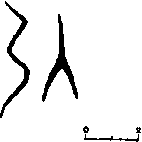
Publications:
Kyzlasov I.L. Runic inscriptions in the Mayak citadel. - Mayak archeological compound. M., 1990,
Fig. 4, p. 19;
Kyzlasov I.L. Euroasian Old Türkic runic script. M., 1990,
Fig. 2.4, p. 27.
Attempts to read:
Never published
Transcription
Not available
Transliteration
Not available
Translation
Not available
Attempts to read:
Never published
D 21. Mayak -18
Graffiti on the
fragment of the chalk block of the fortification wall. One letter among incised
images. Letter height 3 sm.
Date - 9 c.
Found in the Mayak citadel in 1982 during excavations by
S.A Pletneva è G.E.Afanayev.
In custody of the Voronezh University museum.
D 21. Drawing by S.A Pletneva
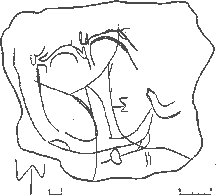
Publications:
Kyzlasov I.L. Runic inscriptions in the Mayak citadel. - Mayak archeological compound. M., 1990,
Fig. 9, p. 19;
Kyzlasov I.L. Euroasian Old Türkic runic script. M., 1990,
Fig. 9.2, p. 27.
Attempts to read:
Never published
Transcription
Not available
Transliteration
Not available
Translation
Not available
Attempts to read:
Never published
In 1975 in the Mayak citadel were restarted the archeological researches headed by S.A Pletneva. They lasted to 1982 and resulted in finding new runic inscriptions. All these monuments were published in 1990 and became subjects of the paleographic study.
In 1978 in the pile of the chalk blocks of the external masonry of the southwest wall 23,5 m to the east from the gate was found a completely preserved block (size 68-70x 41-46x 33-31 sm) on the butt surface of which were incised with a sharp tip unfinished figures of two deers. In publishing of the images the side was given number 28, and the figures - 33 and 3416, field number of the surface 67. The three adjacent long sides of this stone (their field numbers 64, 65 and 66) contained not only figures, but also Runic inscriptions. The inscriptions are with the bottoms of the characters to one side. Taking the top the plane 66 on adjoining 64th side, the runes are "upside down". In relation to the plane 64 in a similar position is the text on an adjacent side 65.
The Inscription D 12 is on a surface 66. The size of the side are 65 õ 32-22 sm, in the central part are two deep cleaves and the parts of the image (during cataloguing of the figures it has received No 54, and the plane No 42; then was also made the brief description of characters D 12 - D 14-18). The horizontal line of the text is placed in the left bottom part of the block. The inscription preserved its all initial length. The letters are made by thin lines, in a number of places by repeated carving. Though the second character suffered the most, its shape is confidently visible. The third character is least clear. The surface damage between the fifth and the sixth characters, probably, was there before the inscription, it was avoided. The adjacent plane 64 has the sizes 70x 41- 46 sm. Small deep cleaves damage the inscription a little bit. The D 13 runs in two horizontal lines, on the whole surface of the block above its centerline. Near the left edge of the stone the inscription run into the carved lines of other origin. Such lines are also in the center of a stone above the text. The characters of both lines are not strictly horizontal. The right runes are above, and the left below the axis of the text. Evidently, letters were rendered from right to left. The sequence of writing the lines is clear also, as the bottom line repeated the configuration on the top. In both lines the characters in the right part are larger and wider than the others, are located more freely, that also testifies to the writing of the text from right to left. In the first line the height of the characters is 3-4 sm, in the second is from 2,5 to 6 sm, but mostly 3 sm. They are cut quite deep (the furrow width is 1-2 mm). The inscription at the left edge of the stone show that both lines reached the edge, and the second line even bent downwards along the side. In the top line are 33, in bottom 32 characters. Now it is impossible to discern 5-6 characters in the left part of each line. Considering the compositional and paleographic features of the inscription, it is possible to suggest that it was written by one person and presents a uniform text consisting of 76-78 characters.
The third inscription of this block (D 14) is on the plane 65 (68 õ 33-31 sm). In the left half is the carved image of a horse. Below it to the right are parts of other engraved images. The horizontal line of the inscription is along the bottom edge of the block. The text does not reach the left side of a stone by 13 sm, the right side by 9 sm. The right characters are larger than the subsequent (4 sm against 2,7 sm). Both circumstances show that the text was written from right to left. 25 characters are visible, 21 letters are distinguishable. From the cleaves considerably suffered the 1st and 8th characters, though the shape of them is confidently reconstructed. Characters 21-24 are damaged to the greatest degree. By its paleographic features the inscription is close to the D 13. Letters were cut on the already smoothed, worn surface of the stone edge. Especially obviously it appears in the left part of the text.
Excavation in 1979 of the internal part of the wall at the southern corner resulted in the detection of one more inscription, D 15. It consists of one character which has been cut on the small side of the block (13,8 õ 12,8 sm), found in the wall veneer pile. Among the huge number of cut and chiseled on the stones of the Mayak fortress characters, tamgas are practically completely absent, being outwardly similar to the letters of the runic texts. Therefore even the individual letters cut on the blocks of this monument is necessary to perceive as written monuments. In a case of the D 15 this proves to be true by the technique and the sizes of the signs, as the tamgas in the citadel were mostly chiseled rather than scratched, and were much larger.
In 1981 during excavation of the external side of the northeast wall of the citadel were found three runic inscriptions. First of them (D 16) is similar to D 15 and consists of one character drawn by a sharp edge on the face side of the chalk block (36 õ 34 õ 24 sm). The stone (field No 32) was found in a pile of the wall. In addition to the face side, the characters are also on its long and narrow side (field No 56). Below and more to the left of the letter are visible long carved lines executed in a similar manner. Later, a deep and wide furrow at the butt end of the stone cut a tamga in a C shape. A similar tamga is also on the long side of the block, and its analogues are on the stone 43 of the same dig. In the same pile of the wall was found a fragment of the block with a five sign inscription D 17 (field No 44). It is made with deep (2-2,5 mm) cuts, clearly visible. The destruction of this side (nowadays it has irregular form, its size is 29 õ 13 õ 18 sm) damaged the bottom part of the third character and, probably, the right part of the text broke away. The extreme right character partially survived. The third inscription, D 18, found on the block in a remaining fifth raw masonry of the wall (field No 48). On an face side (34 õ 21 sm) which had a big area re-planned, survived the left part of a line of the horizontal text. The cuts are rather deep (0,5-1 mm), but the characters are not completely clear. Probably, there were five letters.
In 1982 were found fragments of wall blocks with three inscriptions. The first was in the pile of the internal part of the northwestern wall 20 meters from the western corner of the citadel. The size of the stone 35 õ 31 õ 23 sm. On one side (field No 2) furrowed by the depth of 5-8 mm is cut a tamga-like character, on another, adjacent side (field No 1) is the inscription D 19. The surface is rough, with appreciable traces of planning. The large characters are cut by a thin line (depth of 0,5-1 mm). The shape of the fifth character is not clear, the third character of the inscription did not endure. The character of the text allows to assume that writing avoided the surface damages. It it is possible to explain the greater space between the fourth and fifth letters than between the other characters, there ia a hollow cleave, which has been cut planning the block. The similar reason probably resulted in the shortness of the fifth rune, distinguished from the next in size because of cleaved surface. We believe that the cuts, located between the first and second letters, have no relation to the text and were avoided by the writer. The second inscription, D 20 (field No 22), is found in a pile of the same wall. On the rough surfaces of the fragmentary stone are two runic characters, cut clearly by furrows of 1,5-2 mm deep. The third fragment of the block with the inscription D 21 (field No 34) is found approximately 76 m from the western corner of the wall. On the long side of the block (66 õ 36 õ 32 sm) are the layered linear images and tamga (field No 35). On other surface also are multiplayered images, among which by the thin lines (0,5-1 mm depth) cut a sole alphabetic character. Same as D 16, this single character, probably, is thematically connected to the executed by the similar technique linear images.
Footnotes
C.A.Pletneva in her "Khazars", Moscow 1976, cites
three inscriptions without giving source for two of them:
D-1 "Uma and Angush - our names"
"Elchi, and Ata-ach, and Buka, three of them"
"Kumys, poring in this large throat, drink" (on a flask)
